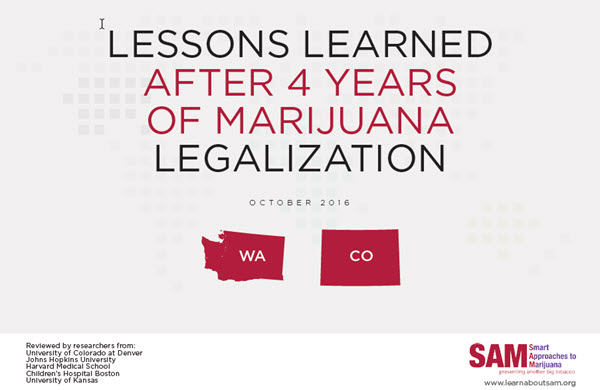Lessons learned after 4 years of marijuana legalisation
 Smart Approaches to Marijuana – October 2016
Smart Approaches to Marijuana – October 2016
FULL REPORT https://learnaboutsam.org/wp-content/uploads/2016/11/SAM-report-on-CO-and-WA-issued-31-Oct-2016.pdf
In the wake of multimillion-dollar political campaigns funded with out-of-state money, Colorado and Washington voted to legalize marijuana in November 2012. Though it would take more than a year to set up retail stores, personal use (in Colorado and Washington) and home cultivation (in Colorado, which includes giving away of up to six plants) were almost immediately legalized after the vote.
Using marijuana in public, which remains illegal under these new laws, has increased conspicuously in both states. Also, a brand-new marijuana industry selling candies, cookies, waxes, sodas, and other marijuana items has exploded—and with it a powerful lobby to fight any sensible regulation.
Though it is still early—the full effects on mental health and educational outcomes, for example, will take many more years to fully develop—these “experiments” in legalization and commercialization are not succeeding by any measure.
Colorado now leads the country in past-month marijuana use by youth, with Washington not much further behind. Other states that have since legalized marijuana occupy 4th place (District of Columbia) and 5th place (Oregon). States with lax “medical marijuana” laws occupy 2nd and 3rd place (Vermont and Rhode Island, respectively).
Additionally, as explained in greater detail below, the laws have had significant negative impacts on public health and safety, such as:
- Rising rates of pot use by minors
- Increasing arrest rates of minors, especially black and Hispanic children
- Higher rates of traffic deaths from driving while high
- More marijuana-related poisonings and hospitalizations
- A persistent black market that may now involve increased Mexican cartel activity in Colorado
The federal government, through the Department of Justice (DOJ), announced it would initially take a hands-on approach to state implementation of legalization, instead promising to track eight specific consequences—from youth marijuana use to use on public lands—and determine action later. So far, however, neither the federal nor state authorities have implemented a robust public tracking system for these criteria. This failure led the U.S. Government Accountability Office (GAO) to criticize DOJ in 2016 for not appropriately monitoring and documenting legalization outcomes. As of the date of this publication, there has been no word from the Department of Justice about state marijuana program compliance with any of the eight criteria it identified. Quietly, however, state agencies such as the Colorado Department of Public Safety, have released very negative updates on marijuana data and other indicators.
In the meantime, the promises of tax revenue windfalls and decreased crime have not materialized. Pot tax revenue comprises a tiny fraction of the Colorado state budget— less than one percent—and after costs of enforcement are subtracted, the remaining revenue is very limited. Colorado schools have not received money for new teachers or smaller class sizes despite pot taxes. And in Washington, half of the marijuana tax money legalization advocates promised for prevention and schools has been siphoned into the state’s general fund.
Topics covered in the report:
- Youth Marijuana Use Since Legalization
- Black Market Activity Since Legalization
- A Possible Link To Homelessness
- Impact on Businesses and the Workforce
- Driving While High
- Emergency Marijuana-Related Poison Control Calls in Colorado
- Edibles: A Growing Public health problem
- Crime and Marijuana
- Tax Revenues






